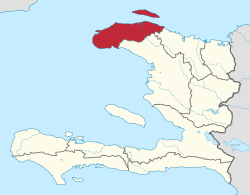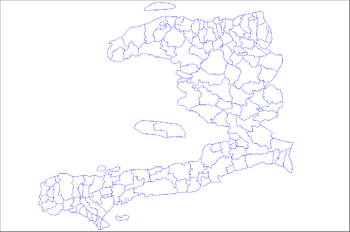Nord-Ouest (department)
Nord-Ouest (Haitian Creole: Nòdwès, English: North West) is one of the ten departments of Haiti as well as the northernmost one. It has an area of 2,102.88 km² and a population of 728,807 (2015 Census). Its capital is Port-de-Paix.
Nord-Ouest Nòdwès | |
|---|---|
 Nord-Ouest in Haiti | |
| Country | |
| Capital | Port-de-Paix |
| Government | |
| • Type | Departmental Council |
| Area | |
| • Department | 2,102.88 km2 (811.93 sq mi) |
| Population (2015)[1] | |
| • Department | 728,807 |
| • Density | 350/km2 (900/sq mi) |
| • Urban | 203,568 |
| • Rural | 525,239 |
| Time zone | UTC-5 (Eastern) |
| ISO 3166 code | HT-NO |
| HDI (2017) | 0.495[2] low · 3rd |
History
Port-de-Paix, which was once a large exporter of coffee and bananas, now imports goods and produce from Miami. Once called Valparaiso by Columbus, there are still some lovely beaches and scenery. Tortuga island, once the biggest pirate bases in the Caribbean is a popular tourist site and is represented frequently in films and movies based on piracy. Named for the smooth shape that reminded travelers of a turtle's shell, Tortuga's best beach is Pointe Saline at the western tip of the small island. This area is very dry and offers little shade but has a beautiful shoreline. At Les Palmiste on the eastern coast visit a pre-Columbian rock carving presumed to be of native Taino origin of a goddess at La Grotte au Bassin exists.
The town of Môle Saint-Nicolas is located in the Nord-Ouest. Ever since Columbus landed here in 1492 and named the island Hispaniola, Môle St-Nicolas has been of interest to the colonials, including the British, Spanish, French, and the Americans due to its strategic location on the Windward Passage, just miles from Cuba. There are several ruined forts along the coast. On clear nights the Guantánamo Province of Cuba can be seen.
Sometime during the 19th century, it was created out of the Nord and Ouest departments.[3]
Geography
With the exception of Tortuga Island and the coastal area near Port-de-Paix, the northwest is mostly arid and barren.
Administrative divisions
The Department of Nord-Ouest is subdivided into three arrondissements, which are further subdivided into ten communes.
- Môle Saint Nicholas Arrondissement
- Baie de Henne
- Bombardopolis
- Jean-Rabel
- Môle Saint Nicholas
- Port-de-Paix Arrondissement
- Bassin Bleu
- Chansolme
- La Tortue
- Port-de-Paix
- Saint-Louis du Nord Arrondissement
- Anse-à-Foleur
- Saint-Louis du Nord
References
- http://www.ihsi.ht/pdf/projection/Estimat_PopTotal_18ans_Menag2015.pdf
- "Sub-national HDI - Area Database - Global Data Lab". hdi.globaldatalab.org. Retrieved 2018-09-13.
- Hall, Michael R., ed. (2012). "Historical Dictionary of Haiti". p. 78. ISBN 9780810878105. Retrieved 29 February 2016.
